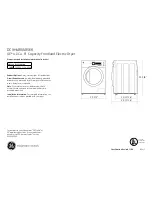
16
Please note that the Drying Times stated below and on the appliance
control panel are a GUIDE only and drying times are affected by:
Items such as towelling retain a lot of water after spinning. The suggested
wash programme for small items such as T-Shirts may sometimes
incorporate a low spin speed which has the same effect.
Your drying load may contain the same type of fabric but of different
thicknesses. Thinner items will take less time to dry. Some fabrics, such as
those used for jeans are of closer texture than others and although light
when dry will be heavy after washing and spinning.
Single items of clothes or small loads may take disproportionally longer
to dry. It is more energy efficient to dry larger loads.
As it takes longer to fully dry clothes than to have them ready for
ironing, you may wish to remove some clothes when they are slightly
damp, ready for ironing and then continue to dry the remainder until
they are fully dry.
The label on the garment should tell you the correct heat setting to
select. See ‘Wash Care Labels’.
If the room in which the dryer is situated is cold, your clothes will take
longer to dry than if the room is warm.
Some bulky items such as padded jackets can be dried, with care, and we
do advise that you remove these items several times, shake them and
return them to the dryer.
THERE ARE HOWEVER SOME ITEMS THAT WE DO NOT ADVISE YOU
TO DRY. SEE ‘ITEMS NOT SUITABLE FOR TUMBLE DRYING’
All fabrics contain a little natural moisture even when ‘dry’ and this
natural moisture should not be lost if the clothes are to remain soft and
fluffy. Clothes that are dried for too long tend to wrinkle and will need
more ironing than usual giving you extra work that the dryer
was designed to remove.
Moisture content
The type of fabric
The quantity of
clothes to be dried
How dry you want
the clothes
The heat setting you
have selected
The temperature
of the room
Bulky items
Be careful not to
overdry
Guide to Drying Times
Drying Guide - approximate drying time in minutes (weights specified are when dry)
COTTONS
SYNTHETICS
ACRYLICS
High Heat
High Heat
Gentle Heat
Drying times 800 - 1000rpm in washing
machine
Drying times on reduced spin
in washing machine
Drying times on
reduced spin in
washing machine
1 kg
30 - 40
2 kg
45 - 55
Half
load
3 kg
55 - 70
4 kg
70 - 80
Full
load
5 kg
80 - 90
1 kg
30 - 40
Half
load
2 kg
45 - 55
Full
load
3 kg
55 - 70
Half
load
1 kg
35 - 50
Full
load
2 kg
50 - 70





































